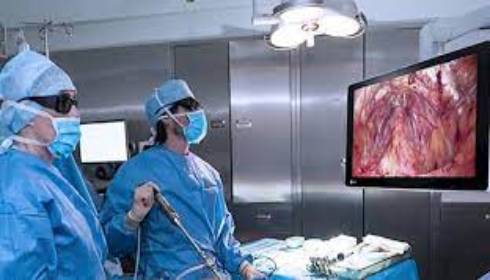
Doctors learn surgeries through 3D 4K aided laparoscopic technique on a theatre screen
Theatre screens, often used for for mass screening of movies or major sports events, was used for doctors who witnessed a 3 dimensional 4K aided laparoscopic surgeries at wide-angle theatre screen in New Delhi's PVR, Chanakyapuri which was telecast by the Institute of Minimal Access, Metabolic and Bariatric Surgery, Sir Ganga Ram Hospital (SGRH).
Doctors emphasised that this technical efficacy has been proven in the air force, retinal surgical field, and robotic surgery.
They added that this has the real-time surgical potential to translate into safer advanced surgery, lower operating times, less blood loss, quicker return to activity and work, and lower overall costs.
“Our immense hope is that surgical safety, efficacy, and overall lower long-term healthcare costs to society are served by the meaningful application of advanced technology such as high-resolution, 3-dimensional, digitally assisted endosurgical imaging,” Dr Sudhir Kalhan, Chairman, Institute of Minimal Access Metabolic and Bariatric Surgery at SGRH.
While elaborating on the features of the technique, Dr Kalhan said, “You can get improved quality images in 4K resolution 3-dimensional LED Monitor. Wearing passive polarised 3D glasses, surgeons can operate with stereopsis looking across the operating room.
“An angle of depth which used to be missed in other techniques has been included in this technique. All these advancements will benefit patients,” he added.
"Organising this workshop (screening live surgery in a theatre) was a challenge for us. We selected PVR because they have 3D technology. Normally, live surgeries are connected through WiFi and satellite but they do not have common bandwidth due to which signals keep dropping and getting resolutions is not easy,” he further added, while talking about the technological challenges encountered.
Pointing out that 3D 4K aided laparoscopic surgery is the next best to robotic surgery, Dr Kalhan added that optical magnification and resolution are the most important features, as they enable the operating surgeon to see better.
“High-resolution, 3-dimensional, digitally assisted imaging is an emerging way of visualising endo-surgery. By attaching a stereoscopic digital camera to the operating laparoscope, a more realistic stereoscopic video can be captured and displayed on a 4K Resolution 3-Dimensional LED Monitor. Wearing passive polarised 3D glasses, surgeons can operate with stereopsis looking across the operating room,” Dr Kalhan explained.
“The advantage of this sophisticated technological arrangement is that the higher optical resolution and depth perception allows larger, higher-resolution monitor screens to be employed in the operating room.
Dr Suviraj John, Senior Consultant, SGRH, said that high-end endo-vision in three-dimensional depth carries with it a huge surgical visual advantage of helping surgeons perceive hitherto unseen vital or critical anatomical detail within the body, providing the complete surgical team with a greater decision-making capability and superior ergonomics.